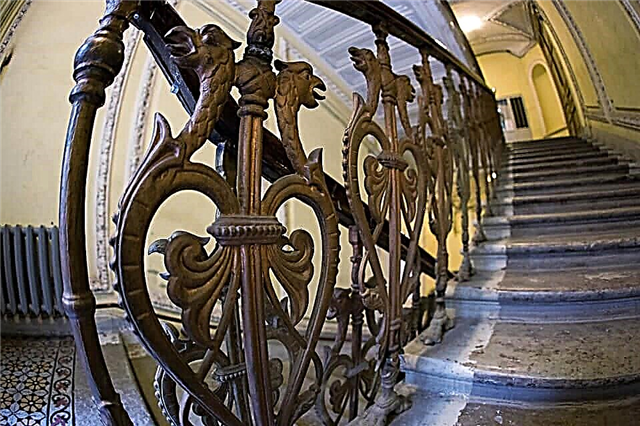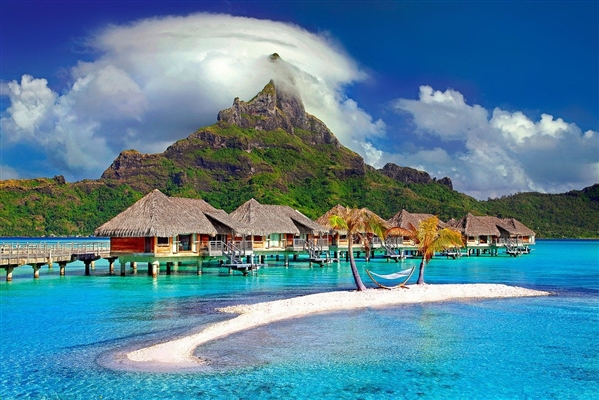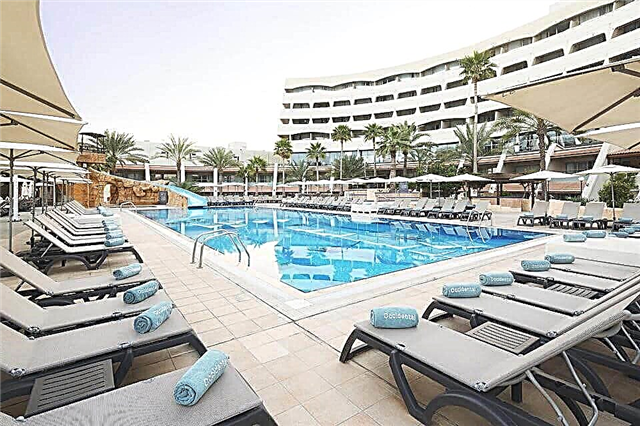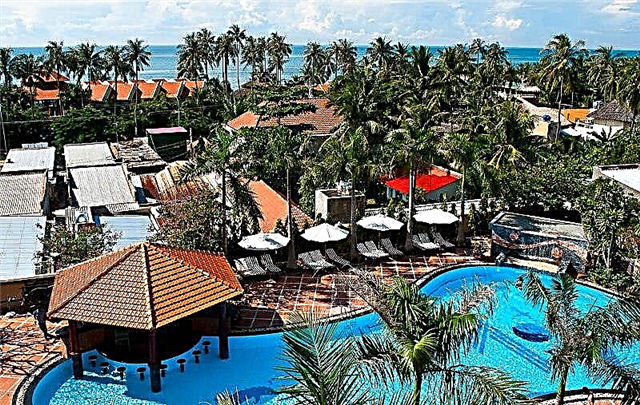The German city traces its history back to a small settlement on the banks of the Parte River. Leipzig constantly found itself in the epicenter of European wars, its population was dying out from disease and hunger. During the Second World War, concentration camps were located here. The sights of Leipzig were destroyed during the hostilities, but the inhabitants restored, erected unique buildings and monuments again. The city miraculously managed to preserve the unique atmosphere that in different centuries attracted people of art to it. Leipzig is named after lindens - trees sacred among the Slavic peoples, symbolizing romance, tenderness, love. Today it consists of 10 urban districts, where more than half a million people of different nationalities live, the largest universities in Europe, museums, and concert buildings operate.
Old town hall

The initiator of the construction of the Old Town Hall is the burgomaster and merchant Hieronymus Lotter. The project belonged to the talented Renaissance and Gothic architect Paul Speck, who was also entrusted with leading the construction. The town hall was erected in the years 1556-1557 on the basis of the foundations of the previous building. This is one of the few surviving Renaissance architectural structures in Germany.
Significant reconstruction was carried out at the beginning of the 20th century.
The peculiarity of the structure is the asymmetrical arrangement of the towers. A passage was built under them, connecting two squares - Rynochnaya and Nashmarkt. Since 1909, it has hosted the Museum of History, the Treasury, ballrooms, meeting rooms, Baroque rooms and the only authentic portrait of J.S.Bach by the artist Naussmann.
Open from 10:00 to 18:00. Tram routes No 4, 7, 10, 12, 14, 15 to “Augustusplatz”.
New Town Hall

The majestic New Town Hall was erected on the site of the 13th-century Pleissenburg fortress, which was dismantled in 1890. In 1897, the municipality announced a competition for the design of a new building on the condition that the architecture resemble a demolished fortress. Hugo Licht's proposal turned out to be the best. By 1905, the construction of the 600-room town hall was completed. Fashionable directions were used in architecture - Gothic and Art Nouveau. The facades are decorated with towers, sculptures, bas-reliefs and bay windows.
In the center rises a round tower 114.7 m high as a reminder of Plaissenbourg. In the interior design, an attractive wooden staircase with fine carvings and a meeting room, the interior of which has not changed since the day of construction. Exhibitions are held in the lower and upper galleries, and the Leipzig restaurant is open in the basement, where the wine cellar used to be. The city council now sits here.
Tram routes 2, 8, 9, 14 to “Neues Rathaus”.
Goliz palace

The palace, which plays the role of a summer residence, was commissioned by the adviser Richter. The mansion immediately after the completion of construction in 1756 became the center of cultural life, where the most famous people of that time came to visit, including the poet Friedrich Schiller. In 1783, the building was transferred to the city property on condition that the architecture of the ensemble not be changed.
During its existence, the owner of the palace was both private individuals and the municipality. After the unification of Germany, the mansion was restored and transferred to the city department of culture. Now it hosts theatrical performances and concerts, wedding ceremonies, vernissages and festive programs.
Visit from 14:00 to 17:30. Get there - by transport number 4 to “Stallbaumstraße”.
August Square

Augustuplatz is named after the first Saxon king Frederick Augustus I. In its place were defensive structures almost until the 18th century. Friedrich August went down in world history as a politician who won popular love for his justice. He abolished torture, forbade the sale of judicial positions, put in order the treasury, founded a number of higher educational institutions and seminaries. The king did his best to keep Saxony neutral.
His only major foreign policy mistake was his support for Napoleon. In order to prevent the partition of Saxony, Frederick Augustus ceded the Duchy of Warsaw and part of the Saxon lands, but was able to preserve the independence of the state and restore the economy, which suffered from the Napoleonic wars. Augustuplatz occupies 40 thousand square meters. The most important city attractions (concert hall, opera and university buildings) are located here.
The square is decorated with two fountains. One of them is named in memory of Marianne Pauline Mende, who bequeathed 150 thousand gold marks for its construction. During the Second World War, Augustuplatz suffered significant damage. Some of the buildings were restored, but the ideas of the German communists to give the city a modern look turned into the dismantling of the Mende fountain, the destruction of the Church of St. Paul, erected in the 13th century, and a number of unique monuments. In the 80s, the 18-meter high fountain was returned to the square. In the 21st century, the temple was restored, and a parking lot was placed underground.
Schiller House Museum

The Schiller Museum was opened to the public in 1848 in a former peasant house, the oldest surviving to this day. Built in 1717 in the village of Golis. By the end of the 18th century, townspeople began to come to the village to rest, the houses were rebuilt for delivery to visitors. Friedrich Schiller rented such an apartment in 1785. Here the poet worked on Don Carlos and the ode To Joy. In September 1841, an honorary gate and a memorial plaque were installed.
In 1995, a grand restoration was carried out, which greatly changed the appearance. He again began to receive guests in October 1998. Today, the exhibition presents about 100 original exhibits and is dedicated to Schiller's works, theatrical premieres of his works and the history of the Leipzig Schiller Society.
Visiting hours: from April to October - from 10:00 to 18:00 all days except Monday; from November to March from 10:00 to 16:00. How to get there: by public transport No 4, stop “Menckestraße”.
Monument "Battle of the Nations"

The most impressive monument in Europe is the Battle of the Nations at Leipzig. It was decided to create the monument at the beginning of the 19th century. By the 50th anniversary of the battle in 1863, the first stone was laid, but the plans were not realized until the end of the century. Only in 1898 the architect Bruno Schmitz prepared a blueprint for the monument, after which construction began. Funding came from donations and a specially organized lottery. Erected in honor of the victory of the allied armies in the fight against Napoleon.
The battle took place on Saxon territory in the fall of 1813, and thanks to the successful action of the coalition, the emperor had to retreat to France. The height of the monument is 91 m. One climbs to the upper platform on foot along the stairs or uses the elevators, which rise to a height of 57 meters to the observation deck. The Hall of Fame, located inside, is decorated with images of 324 horsemen. In the hall there are 4 statues of memorials of 10 meters in height, personifying the power of faith, courage, dedication and power of the people.
Open from November to March from 10:00 to 16:00, from April to October until 18:00. It is convenient to get there on routes 2 and 15.
BMW plant central building

The BMW plant shows the impact of architecture on the success of a team. The structure accommodates administrative departments, quality control rooms, design services. The departments are connected to the production area, which consists of bodywork, assembly and paint shops. The plant was opened in the former GDR not by chance - unemployment in this part of Germany is higher than in Western Germany, and the labor force is much cheaper here.
The company began producing cars in the spring of 2005; at present, the capacity is 700-800 units daily. The factory organizes excursions, during which visitors are told about the production processes.Held from Monday to Friday, from 08:00 to 18:00 on request.
Church of St. Nicholas

The temple was built in 1165. Over its centuries-old history, it was reconstructed many times, therefore the appearance combines several architectural trends - Gothic, Classicism and Renaissance. The wall paintings, luxurious stucco moldings, an old organ and a carved pulpit are impressive. In this church, for the first time, Bach's "Passion for John" was performed, and here is the grave of Petrus Mosellaus, a humanist, philologist and Roman Catholic theologian.
In 1989, local residents gathered in the church of St. Nicholas, who participated in the movement for the destruction of the Berlin Wall and the unification of Germany. Currently, the parish is Lutheran, sometimes Catholic masses are held. Organ music can be listened to once a week.
Working hours: Sunday services at 09:30, 11:15, 17:00. The church can be reached by routes No. 4, 7, 8, 10 to “Augustusplatz”.
St. Thomas Church

The name of the temple, built in the 13th century, is associated by many tourists with the music of Bach. The great composer served as the cantor of the choir in this church for 27 years and was buried there. Near the wall of the main temple in the fate of the genius, the townspeople erected a monument to Bach. Mozart performed his works in the same building. And the relics of St. Thomas were presented to the temple in the 13th century by the legendary minstrel Heinrich Morungensky, who took monastic vows. His love lyrics at one time were considered the standard of praising female beauty.
The Christian theologian-reformer Martin Luther held a festive service in the church of St. Thomas, which went down in the history of the city, calling on believers to repentance and freedom of the soul. The building has been rebuilt several times, its modern appearance corresponds to the canons of the late Gothic and Neo-Gothic styles. The height of the church is 18 meters, the length is 76 meters. The height of the bell tower, whose construction dates back to the 16th century, reaches 68 meters.
Its largest bell "Gloriosa" (the name in translation from Latin means: "Glorified") was made in the 16th century. The temple was damaged during the Second World War, but the name of Bach protected it from the attempts of the communists who came to power to eliminate the religious building. There are 3 organs in the building today: one created in the 19th century, a copy of an 18th century musical instrument, and a portable one (digitally made in the 21st century). The church serves as an educational and cultural Christian center.
Tram number 9 to “Thomaskirche”.
Temple-monument of Russian Glory

The monument was designed by the architect V.A.Pokrovsky. It was built in the style of Russian hipped roof structures of the 17th century. In Russian society, there has long been talk of perpetuating the memory of the soldiers who died during the Napoleonic campaign. It was built on donations from parishioners, for this, a committee for the construction of the temple was organized.
The city authorities have allocated a plot of 2.6 hectares for construction. The first stone was laid in December 1912 - consecrated in October 1913. The ceremony was attended by the Grand Russian Duke Kirill Vladimirovich. The remains of the Russian soldiers were solemnly transferred to the crypt. Several times the memorial church was closed, plundered, it passed under various jurisdictions. Now belongs to the Russian Orthodox Church.
Located on Philipp-Rosenthal-Str., Not far from the Battle of the Nations monument.
Southern Cemetery

In the middle of the 19th century, the population of the city increased significantly, an additional cemetery was required, the design of which began in 1879. In 1886, the South Cemetery was 82 sq. km was opened. In 1910, a chapel with a bell tower, as well as a crematorium and columbarium were erected. This is the largest of the park cemeteries in Germany with equipped alleys, sculptures and green spaces. For the neo-romantic style complex, the Laach Abbey in Eifel was taken as a model.
The cemetery can be reached by tram 15 to the “Südfriedhof”.
Bach Museum

The building is located near the Church of St. Thomas. The Baroque house belonged to a Leipzig merchant in the 18th century. Nearby there is another architectural monument associated with the composer's activities: the school of St. Thomas, where he taught and lived (according to the traditions of that time) Johann Sebastian Bach. The great creator of sacred music spent the last 27 years of his life in Leipzig. His office as cantor of the church choir in the Church of St. Thomas included the duties of conductor, organist, and teacher.
The genius was distinguished by a hot-tempered character. Bach's main support was his family, whose support allowed him to survive any difficulties. Naturally, a significant part of the museum exposition is dedicated to his family. Here you can see the originals of musical notations of the composer's spiritual and secular works, musical instruments made in the 18th century. The museum has a unique collection of audiovisual recordings of performances of Bach's music.
Among the relics, a special place is occupied by a part of the organ from the Church of St. John. The musical instrument was tuned by the composer at one time. The temple was destroyed during the Second World War, its surviving (restored at the expense of the parishioners) tower was blown up 20 years later by the decision of the local authorities. Today the museum is one of the subdivisions of the Bach Archives, a research and documentary center founded in 1950.
Open from 10:00 to 18:00, except Monday. Take bus number 89 to “Thomaskirche”.
Mendelssohn's apartment-museum

The outstanding composer, pianist, conductor lived for 38 years. He was called "Mozart of the XIX century", one of the most popular representatives of the direction of romanticism. After his death, the work of the composer was severely criticized and Jacob Ludwig Felix Mendelssohn Bartholdi was reminded of his Jewish roots. From 1835 he took an active part in the cultural life of Leipzig and died here. Mendelssohn contributed to the opening of the city conservatory, where he taught since 1843.
An eight-room apartment on the second floor of a Leipzig building, built in 1844, turned out to be the only place of the composer's life that has survived to this day. Mendelssohn had a happy marriage, but for the sake of his unrequited love for the Swedish opera singer Jenny Lind, he wanted to leave his wife and children, to flee to America. The museum apartment contains drafts of sheet music for works dedicated to the femme fatale in the composer's life.
It is noteworthy: the personal archive of the singer has not been published (in order to avoid public resonance) even 100 years after her death. The founders of the museum managed to recreate the original furnishings of the rooms, acquire furniture that belonged to Mendelssohn, and original letters. The apartment was opened to the public in 1996. After 18 years, the area of the museum has increased due to the premises on the ground floor, where a music salon operates and an effectorium is equipped. In the latter, adults and children can feel like conductors of a virtual orchestra.
It is convenient to get there by tram number 2, 9, 16 to Rossplatz.
Grassi Museum

The museum complex is named after a merchant who bequeathed 2 million marks to the city for the construction of buildings for cultural institutions. The complex unites several museums: ethnographic, applied arts, musical instruments. In the 19th century, the Grassi Museum occupied a building on Place Royale. The collections increased, and the city authorities decided to build a new cultural center. The object was built in 4 years, its architecture reflected the prevailing Art Deco and new objectivity trends at that time.
The museum ensemble consists of buildings with a height of 2-3 floors. The buildings are arranged so that they frame 4 courtyards. A significant part of the museum's exhibits was destroyed during the Second World War. The buildings were restored after the bombing, but in the 80s, due to the failure of the heating system, the complex was closed for public visits.
At the beginning of the 21st century, after extensive restoration work, access to the Grassi Museum was opened.Today his collection of applied art is considered one of the finest in Europe. The collection of the ethnographic museum has about 200 thousand exhibits. The collection of musical instruments contains 10 thousand items, the age of its oldest relics reaches 400 years.
Tram lines 4, 7, 12, 15 to “Johannisplatz”.
Market Square
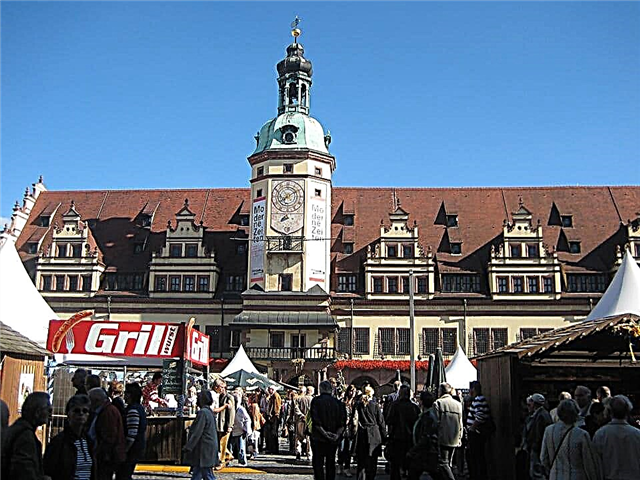
The history of the market square dates back to the 12th century, when the Slavic settlement located on the site of Leipzig received the status of a city and the right to free trade. There are versions that it is more than 900 years old. The trade heart of the city was the intersection of two roads: Imperial and Royal. A square arose here, where the famous autumn and spring fairs were held in Europe. Later it was moved, surrounded by new buildings.
The square was rebuilt several times. It went down in history as a place of public execution of criminals, battles of knights in tournaments. In the late 19th - early 20th centuries, the square acquired the status of a trade and exhibition center. The huge exhibition hall, where the tunnel passes today, was located underground.
On the territory of the market square, there is the Old Town Hall, erected in the middle of the 16th century, which houses a concert hall and a museum.
The Old Exchange and the house where the genius thinker Christian Thomasius was born (his philosophical and legal works influenced the development of world science) are preserved nearby. Nearby, on the site of the first coffee house in the city, there is the Museum of the Coffee Tree, on the next street there is the oldest Leipzig restaurant, immortalized in Goethe's tragedy "Faust". The Old Libra is another iconic building, which is not inferior in importance to the Royal House located right there on the square.
Art Museum

The basis of the cultural fund was made up of collections of individuals, which were replenished with new exhibits over time. Hans Peter Buhler and his wife made a significant investment - they presented a collection of French painting. The first building for the museum was built in 1858 - an elegant palace in the style of the Italian Renaissance. During the war it was destroyed, so for 40 years the exhibits were exhibited at the Dimitrov Museum.
At the beginning of the XXI century, a new structure was erected, representing a glass cube with numerous terraces and stairs. Different materials were used in the interior design - glass, concrete, wood, shell rock. The collection features medieval and contemporary art.
Schedule - 10: 00-18: 00, Wednesday 12: 00-20: 00. How to get there: tram number 3, 7, 9.15 to “Goerdelerring” or “Hauptbahnhof”.
Concert hall Gewandhaus

It is believed that the tradition of holding "Great Concerts", which was given by orchestras of 16 musicians, began in 1743. After a break, a collective of 30 orchestras called "Amateur Concerts" resumed their concert activities. In 1835-1847 Mendelssohn was the director and conductor of the Gewandhaus Symphony Orchestra. During this period, an original creative style was developed, and the repertoire was supplemented by the immortal works of Bach, Beethoven and contemporary authors.
After the war, the team moved to a modern building, which includes two halls, one for 1900 spectators, the other for 498, excellent acoustics everywhere. Symphony and brass bands, children's and adult choirs, conferences and congresses work in the Gewandhaus.
Opening hours: excursions are held on Saturdays. How to get there: to “Augustusplatz” by tram No. 4, 8, 10 14, 16.
Opera theatre

One of the oldest opera houses in Europe was founded at the end of the 17th century, when its first building was opened. The latter turned out to be erected with construction errors. It was demolished, and the Leipzig Opera was built on Augustus Square. The inauguration of the facility in 1868 was attended by the royal family of Saxony. Over the years, works by Mozart, Gluck, Weber, Weill have been successfully staged here.
The Leipzig Opera House is interesting in that its repertoire to this day combines classical and modern operas, but the leading place among the performances is occupied by the works of Richard Wagner - one of the most difficult to perform. In 1943, the unique building was destroyed; in its place, 13 years later, the construction of a new theater began. The 52-meter-high object erected on the square corresponds to the canons of the Stalinist Empire style.
In total, over 44 million marks were spent on construction, finishing work and materials. The size of the theater, the luxury of its interior and exterior solutions amaze the imagination. The technical equipment of the building remains one of the best in Europe today. The main hall of the theater can accommodate over 1200 spectators. The building has a chamber hall where concerts, lectures and exhibitions are held.
How to get there: route No. 4,7,8, 10, 11, stop “Augustusplatz”.
Main station

The competition for the creation of the railway station project was announced at the beginning of the last century. The work of local architects William Lossow and Max Hans Kuehne was recognized as the best. The construction of the station began in November 1909, six years later (1915) it received the first passengers. The structure is striking in the length of the facade - more than 300 meters. After Germany was united, a general reconstruction was carried out. Serves 150,000 passengers daily. The complex houses about 100 shops and kiosks, numerous cafeterias and restaurants, hairdressers - everything is provided for the convenience of passengers.
Ancient coffee house "By the Arabian coffee tree"

The legendary coffee house claims to be the oldest in Europe (competitor is the Parisian cafe Prokop). This is a cultural monument, it is believed that coffee began to be prepared and sold here since 1711. The famous cafe was visited by famous people of that time, and Schumann often met at the institution with friends, a table was even assigned to him. In 1720, a sign appeared above the entrance to the cafe, depicting a man in oriental clothes. He presented a cup of coffee to a European as a sign of friendship. The drawing prompted the owners of the establishment to give such a strange and long name. Today, dishes of French, Arabian, Viennese cuisine are prepared here. The institution is waiting for visitors every day.
How to get there: by tram route No. 9 to the stop “Thomaskirch”.
Auerbach's cellar

The cafe is one of the oldest establishments in the world, located in the old city center. The restaurant is divided into four small rooms for up to 40 people. At this place, according to documents, wine was traded in the 15th century. Named for Stromer, the owner, better known as "Dr. Auerbach". The institution is very popular, so tables here are booked in advance. In front of the entrance there is a bronze sculptural composition depicting Doctor Faust accompanied by Mephistopheles.
During his studies at the University of Leipzig, Goethe often came here. Once the writer heard the legend about the warlock Faust, who was seen galloping up the stairs on top of a barrel, and the devil himself was allegedly involved in this incident. Impressed by this amazing story, Goethe wrote the immortal tragedy Faust, in which the first chapters were set in this institution.
The hall is open from 11: 30-24: 00. How to get to Auerbach's Cellar: city transport no.9 to Thomaskirche.
Shopping complex "Madler-passage"

The Passage Madler shopping center owes its appearance to businessmen - Stromer and Madler. On January 1, 1911, friends acquire a plot and begin construction of the Passage, which lasted until 1914. Since its inception, it has been used as a showroom for wines, porcelain, ceramics and leather. Autumn and spring fairs, popular in Europe, are held here every year. Complex repairs and restructuring took place at the end of the last century, within two years the Passage was completely repaired. The five-storey building was complemented by glass roofs and a rotunda.
There are many boutiques in the mall where you can buy your favorite item with a good discount.The hotel is open and the bar "Mephisto" is open - a popular place among locals and tourists, equipped in red and black colors.
How to get there: by public transport No 9 to “Thomaskirche”.
Zoo

The organizers of the zoo care about the welfare of pets and the preservation of animals - this is the main thing in their work. Here, means are used that allow the inhabitants to feel like in their own home, and not in an artificial environment. This is evidenced by the design of cages and aviaries, as well as the natural material from which they are made - wood, stone, jute. Programs are used to preserve endangered and rare species of animals. The pride of the organizers in obtaining offspring from rare and disappearing animals.
The Gondwana exposition is very popular among children and adults. This is a pavilion the size of two football fields, representing the wildlife of the tropics. Other, no less interesting expositions tell about the nature of Europe, South America, savannahs.
Open from November to March - 09:00 to 17:00, from April to October - until 18:00. Tram route 12 to the stop “Zoo”.
Alte Waage

In 1555, a building was erected on the Market Square, where the goods prepared for sale were weighed - the Chamber of Weights and Measures. In 1820, the oee was transferred to another building, and the former place was called “Old Weights”. Then a trading house was built in Alta Vaage, a travel agency has been operating in the restored premises since 1964, and a large insurance company has settled here since the end of the last century. The building is three-storey, with a basement and two attic floors. With its Renaissance-style façade, the Alte Vaage faces the Market Square. The pediment is decorated with motifs of currency and a sundial. The eastern side of the facade is designed in a modern style.
Leipzig is a beautiful city full of architectural masterpieces, ancient monuments, unique modern buildings, shopping complexes. It makes an indelible impression on any person, remaining in the memory for many years.
City History Museum

The City History Museum occupies several sites. Its exhibits are located in the old buildings of the town hall and stock exchange, a modern multifunctional complex, the Schiller house-museum, coffee and sports museums. The Battle of the Nations monument is one of the visiting cards, the largest monument in Europe is also a branch of the museum. The creation of a unique collection began in the second half of the 19th century.
For several years, the townspeople, united in a historical society, managed to find and purchase over 5 thousand rare items. The first exhibition of artifacts was opened in 1889. At the beginning of the 19th century, the society donated the collection to the city for the future museum. During the Second World War, a significant part of the exhibits was evacuated, which made it possible to save rare artifacts. Later, the museum was reorganized, the structure and name of the institution changed.
Currently, more than half a million items are stored in its funds: graphics, coins, awards, household utensils, clothing, jewelry, musical instruments, glass negatives, antique vehicles and much more. Most of the exhibits have virtual copies. The latter can be found anywhere in the world using Internet technologies.



